Recent Articles
Popular Makes
Body Types
2015 Dodge Charger SRT Hellcat Full-Size Sedan Review
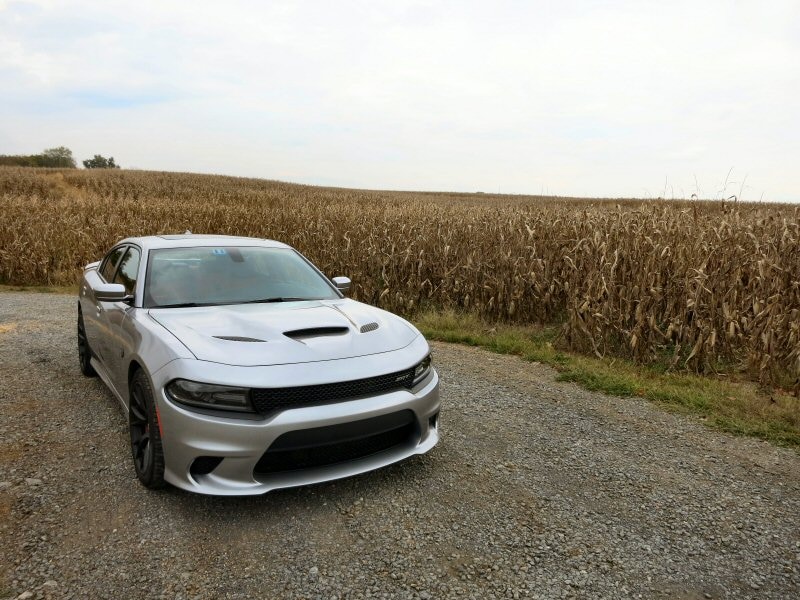
2015 Dodge Charger SRT Hellcat ・ Photo by Benjamin Hunting
It was the worst best-kept-secret in the auto industry: after the unveiling of the Dodge Challenger SRT Hellcat and the phenomenal 707 horsepower sitting under its muscle car hood, speculation immediately began to swirl around the idea that the Dodge Charger could see its own Hellcat edition in the near future. After all, both of these Chrysler products share a near-identical platform, which would make producing a radical four-door Hellcat as simply as programming a few robots on the assembly line to grab this V-8 engine instead of that one and stuff it where it doesn't belong.
That could have been how the 2015 Dodge Charger SRT Hellcat design process unfolded, but fortunately for fans of affordable - and excessive - power, the engineering decisions surrounding the world's most powerful sedan occurred at a much higher level. The Charger SRT Hellcat is more than just an overcompensating engine plucked from muscle coupe glory and deposited in a full-size family car: it's a complete re-thinking of the Charger concept that is intended to paint as much speed, handling, and style as possible onto the vehicle's basic canvas. After having sampled the Charger SRT Hellcat on both the hot asphalt of West Virginia's Summit Point Motorsports Park and the soaking wet concrete that makes up Washington D.C.'s Beltway, I can attest to the blistering success of the four-door Hellcat formula.
Familiar Shape, New Details
We have already seen the redesigned 2015 Dodge Charger at the New York International Auto Show earlier this year, but it's worth reiterating the new model's revisions to the big sedan's styling cues. Specifically, Dodge has found a way to make the already aggressive Charger simultaneously sleeker and more menacing, and this has been accomplished largely through a series of adjustments made to the car's lighting profile.
Chrysler as a whole has adopted exterior illumination as a core tenet of defining vehicular personality - witness the Jeep Cherokee and Grand Cherokee as prime examples of this trend - and the Charger is no different. Up front the car gains LED fog lights and wrap-around LEDs for the headlights that cant upwards into the front fenders, framing a crosshair grille that has been rounded to match a more curved hood and bumper arrangement. The rear of the car sees the most dramatic embodiment of Chrysler's lighting philosophy, with the taillights adopting the ' LED racetrack' all-the-way-around design that gives the Charger SRT Hellcat a truly distinctive character.
Of course, the Hellcat also gains its fair share of unique attributes compared to lesser members of the Charger family, and these seem split between aero-enhancing tweaks and pure style-oriented whimsy. Starting from the back this time, keen eyes will notice the vents that have been carved out just behind the rear tires on the Charger SRT Hellcat's fenders. These serve no performance purpose, other than to 'let out some tire smoke' according to SRT engineers. Lift your eyes to the trunk, however, and you'll find a one-piece spoiler integrated to the deck lid that replaces the three-piece unit found on the regular Charger, and this has a definite downforce effect on the sedan as it approaches its 204-mph terminal velocity. The Hellcat's hood carves a huge air intake and a pair of heat extractors out of its aluminum shape, and underneath the revised front bumper sits a splitter the directs air towards the car's additional engine and supercharger cooling systems (with some of that hardware positioned directly behind the bumper itself). The entire silhouette sits on 20 inch rims that are 9.5 inches wide in order to accommodate the Pirelli Y-Plus rated rubber that glues the car to the tarmac.
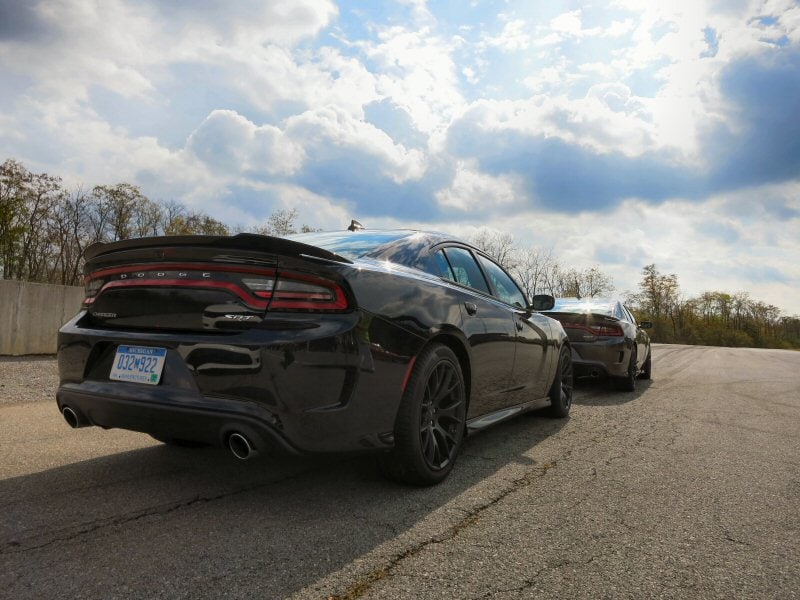
Photo by Benjamin Hunting
Revelations Inside
As with the Challenger SRT Hellcat that came before it, the 2015 Dodge Challenger SRT Hellcat has seen its interior take a big step forward in terms of overall quality and design. A thick, meaty steering wheel sits in front of a pair of red-bordered analog gauges, which themselves frame a configurable LCD center display. On the car's dashboard you'll find the latest Uconnect 8.4 touchscreen interface, which is an industry leader in terms of functionality and graphics, and just underneath that sit the climate controls and the SRT button that accesses the car's many customization features.
The Charger SRT Hellcat's dash and door panels are curve-heavy and covered in some of the softest materials ever to have graced a full-size Chrysler product. While the area in front of the passenger might seem a little barren compared to what the drive has to contend with, I was suitably impressed by the variety of two-tone leather packages available with the car, including a set of gorgeous baseball mitt-style tan seats that were ultra-plush and quite comfortable both on an off the track.
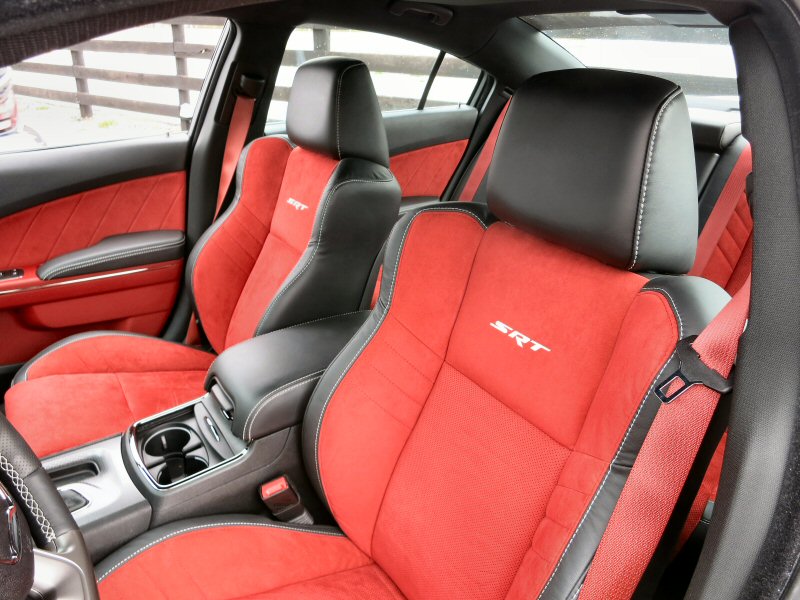
Photo by Benjamin Hunting
Start Your Engine
The 2015 Dodge Charger SRT Hellcat offers a pair of keys - one black, one red - with the first intended to hinder and the second to enhance your driving pleasure. The black key limits the output of the SRT Hellcat's 6.2-liter supercharged engine to a mere 500 horsepower, a seemingly arbitrary number that is still more than enough to do some serious damage out on the road but which has been deemed 'safer' than the 707 horses unleashed by the Charger's red key. There's also a further 'valet mode' that clamps down even harder on the amount of fun that can be had behind the wheel of the sedan.
Naturally, it was red key all the way for me when sliding into the Hellcat's driver's seat in the pit lane of Summit Point Motorsports Park, a short but flowing track carved out of the hill country of West Virginia. A push of the starter button on the dash unleashed a snarling, muted exhaust note that spoke to the supercharger muffling the eight-cylinder engine mounted between the car's front fenders, a unit that can pump 11.6 psi of air all day long thanks to a relentless focus on resisting the kind of heat that can build up when driving back-to-back track sessions. The blower itself actually requires a hefty 80 horses to turn its screws, and it makes itself known under full throttle by way of a pleasing whine that cuts through the thunder of the car's twin tailpipes expelling 650 lb-ft of torque at a high rate of speed.
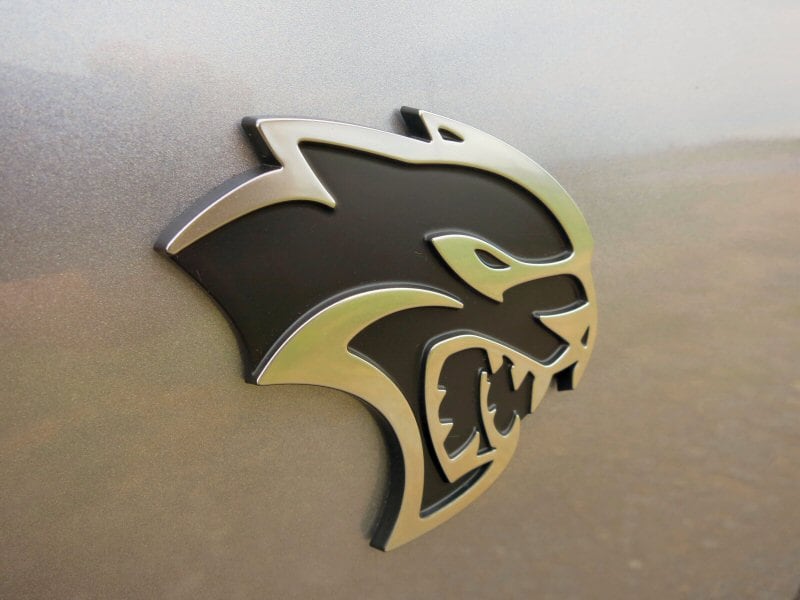
Photo by Benjamin Hunting
Well-Behaved Hooligan
Leaving pit lane gave me the first of several 'oh [expletive redacted]' moments related to the Charger SRT Hellcat's hyperactive throttle response. With the car set to 'Track' mode the sedan's engine and steering are set to their most sensitive, and its suspension and transmission stiffen up to the greatest possible degree. The result is a big car that's willing to dance at a more frenetic pace than one might expect given its substantial curb weight (unreleased, but assumed to be over 4,400 lbs). Track mode also means that you've got to stay on your toes in terms of what the car is communicating to you through its chassis in order to avoid the risk of overpowering its 20-inch rubber on corner exit.
After having driven the Challenger SRT Hellcat on the tighter road course at Portland International Raceway, I was expecting its four-door sibling to offer the same type of disquieting, on-the-edge experience that would leave me sweaty and unsettled at the end of the session. I was wrong - the Charger SRT Hellcat's platform was much better behaved when asked to corner quickly, brake hard, and pivot its unwieldy mass from side-to-side. I never felt uncomfortable pushing the bigger Hellcat, compared to how nervous the coupe edition had made me, and I was shocked at how insulated and controlled the car felt even when cresting the 144-mph mark at the end of Summit Point's brief front straight. The car's 15.4-inch front Brembo disks and six-piston calipers hauled the car down to negotiate the subsequent right-hander at the end of that section with a minimum of drama, and the vehicle's eight-speed automatic transmission (which is a match for the unit found in the Challenger) performed admirably when it came to anticipating shift points, holding on to gears when appropriate and slowing the car in a controlled manner while negotiating the circuit's slower S-curves.
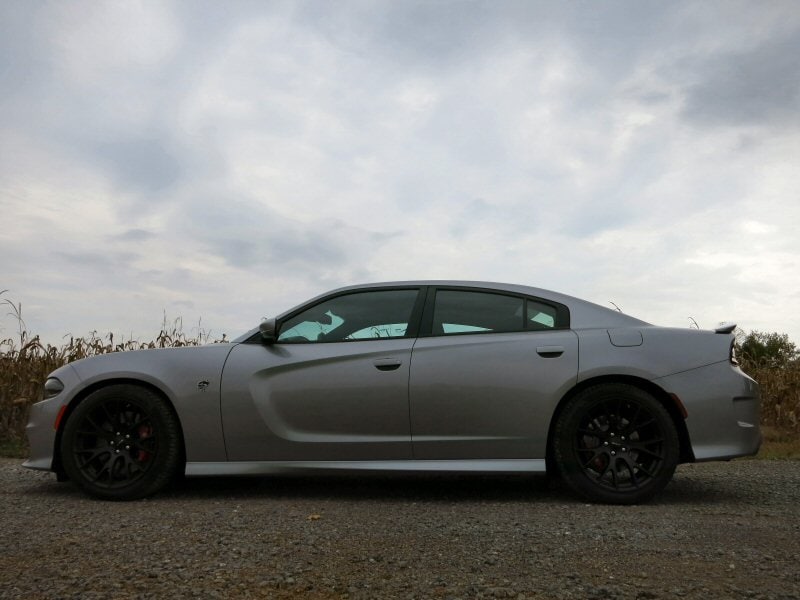
Photo by Benjamin Hunting
Jekyll and Hyde Drive Modes
All's well that ends well on the track, but I discovered a different side to the 2015 Dodge Charger SRT Hellcat's character when tooling around the secondary roads that connect Summit Point to the highways encircling nearby Washington, D.C. It was here that the sedan's portly weight revealed itself to be more a liability as undulating roads saw the car pitch and roll when driven enthusiastically. I found that the Charger's launch control system performed more reliably than the Challenger's on street tires, reeling off four second 0-60-mph times one right after the other, but I had to be much more careful with the accelerator in normal driving as the threat of immolating the rear tires at any speed was constantly lurking in the background.
A sudden downpour that caught us on the way back to the hotel in D.C., however, proved the point that if driven responsibly there's no reason - aside from the enormous monthly fuel bill - that the Charger SRT Hellcat couldn't stand in as a daily driver. The wet conditions posed no problem for the sedan's electronic nannies when the car was set to Street mode, nor did it elicit any unexpected hair-raising behavior from the car even when I deliberately provoked it.
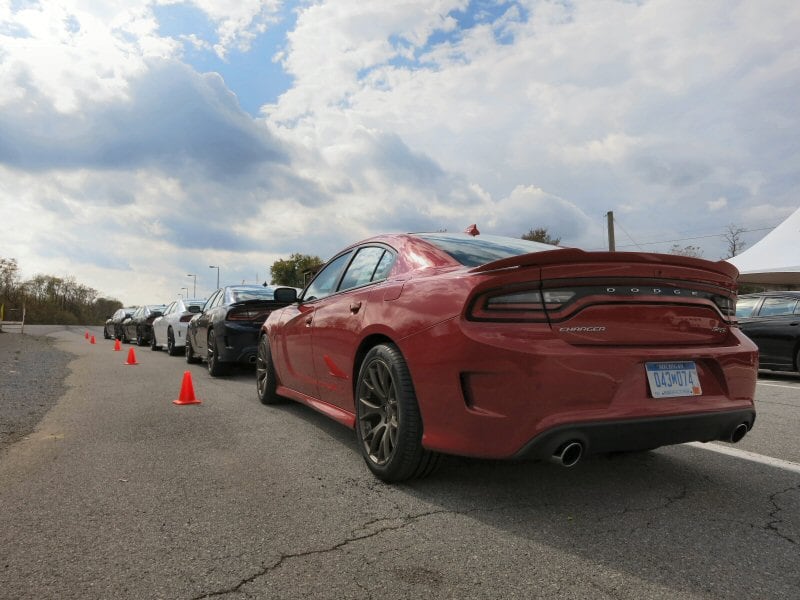
Photo by Benjamin Hunting
A Car No One Needs, But Everybody Wants
There's never been focus group in history that has ever created the kind of car that stirs the passions of automotive enthusiasts, and so it comes as no surprise to me that the most dynamic member of Dodge's full-size sedan family is one that, in the words of SRT CEO Tim Kuniskis, 'has no business case.' Although it trumpets its 707 horsepower and 11.0 second quarter mile, the 2015 Dodge Charger SRT Hellcat can't be explained by empirical data, no matter how many spreadsheets, engineering documents, and marketing materials are stacked in its corner. You might as well throw all of that paper in a bonfire the minute the red key works its magic and the Hellcat's supercharged engine sings to life, because this is a car that demands an emotional connection predicated on the rejection of rational though.
It's also one that's relatively affordable, starting at $63,995, which seems a pittance to pay for the bragging rights of owning the most powerful four door automobile in the world. With its roomy interior, quotidian commuting capability, and less-twitchy on-track personality, the Charger SRT Hellcat simply makes more sense to me than its Challenger twin - at least, in a world where the existence of 707 horsepower Dodges makes any sense at all.
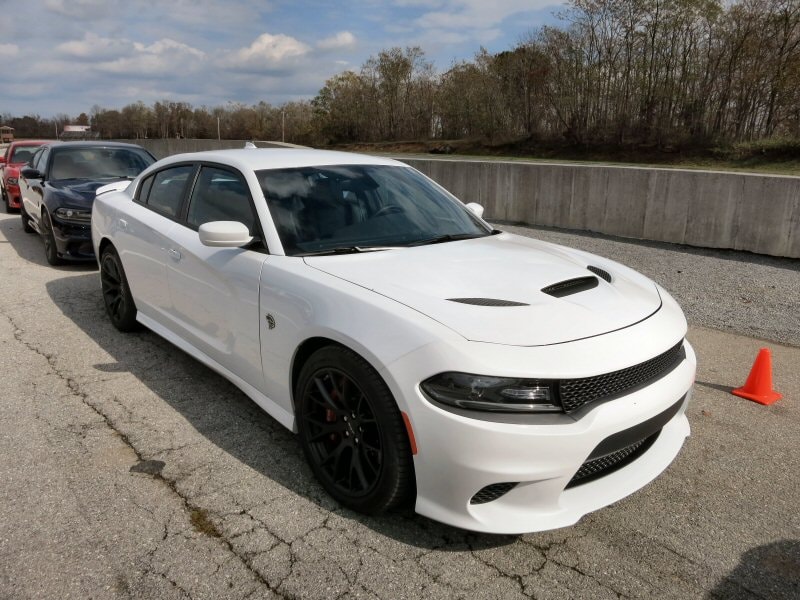
Photo by Benjamin Hunting